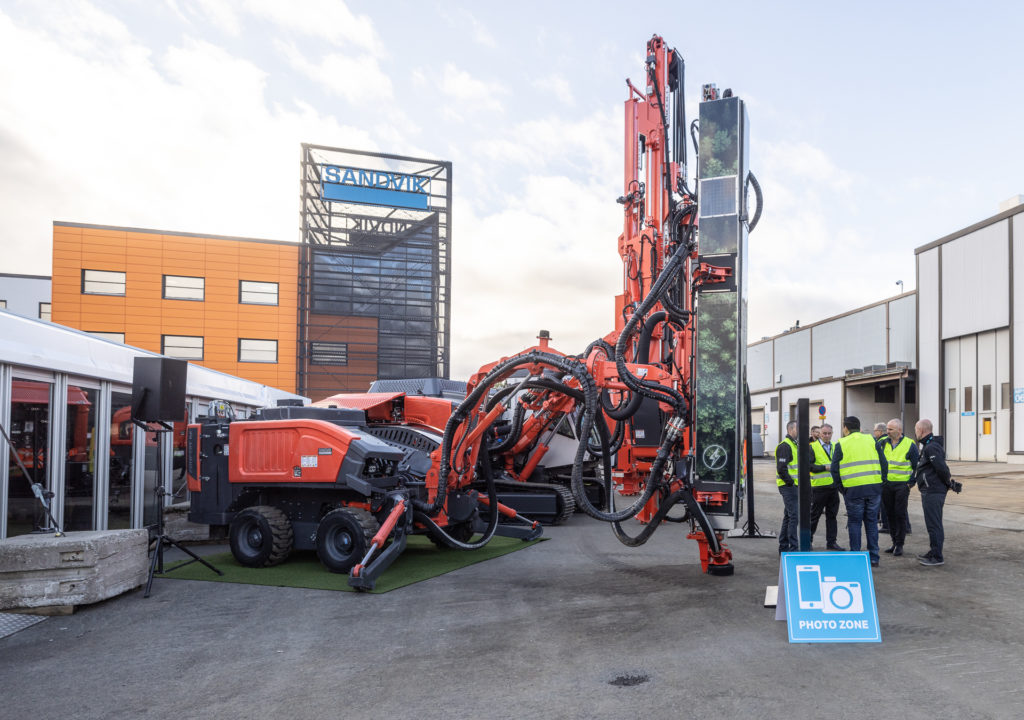One of the innovative machines Sandvik Mining & Rock Solutions showcased at this year’s Innovation in Mining customer event in Tampere, Finland, attended by IM, was its fully electric concept rig, based on the compact CommandoTM DC300Ri top hammer drill rig.
Sandvik says the concept drill rig is essentially a versatile R&D platform for demonstrating the most advanced, but nevertheless proven and validated, sustainability technologies that are already in use or coming soon on underground drill rigs and loaders. The concept rig is rubber tyred, utilises lithium batteries and uses a plug-in charger. It is also cabless and is operated via teleremote line of sight technology.
In quarrying adjacent to urban areas or on large construction sites you typically have plug in charging available. This particular rig also has a back-up diesel genset in case there is a temporary situation when plug in charging is not possible. It has rubber tyres as in the types of markets where it is operating you don’t need the extra traction from crawlers but it can still negotiate quite rough terrain. The rig has already been trialled by contractor Norrbottens Bergteknik eand has recently moved on to another customer for additional testing. The typical power levels on a rig of this size also allow a feasible full battery solution today. And it is worth remembering that the duty cycles of these sites are very different to mining so therefore there are much lower power demands.
Lauri Laihanen, Vice President, R&D and Product Management, Surface Drilling Division, Sandvik Mining & Rock Solutions

IM Editorial Director Paul Moore sat down with Lauri Laihanen, Vice President, R&D and Product Management, Surface Drilling Division at Sandvik to better understand how this small rig can be seen as the very start of a transition to battery electric in surface mining drill rigs. He says: “It will help us better understand how the battery electric technology works in surface drilling applications, as opposed to load and haul where of course we already have vast experience. The reason why we chose the small unit first is from a customer point of view that’s where the biggest initial pull is – from quarrying customers that operate near urban areas to large construction sites for example, road/railroad construction and foundation drilling.”
In that industry Laihanen says you are actually seeing some municipalities put out tenders including requirements that equipment needs to be electric with zero/minimal emissions and stringent noise level limits with often defined sustainability targets.
So what about moving into mining? Going straight into crawler DTH rig sizes used in mining like Sandvik’s Leopard range, battery energy densities are not yet there to allow it to operate for a full shift because even the smallest DI450 model requires 250 kW of power and based on typical power consumption of these drills over a shift it isn’t feasible.
But on the smaller top hammer side it is starting to look more realistic at least for the majority of a shift if not the whole shift. Already Laihanen says that battery is feasible for the smaller Dino rigs such as the DC410R/DC410Ri and DC420Ri which only require 105 kW of power. That said, in mining there are unlikely to be operations where you can use top hammer drilling only – so top hammer may come first for all battery operation followed by DTH. We need to develop any solutions together with our customers.
“We are starting small with the electric concept rig. We will prove and build the concept on smaller rigs and get them to commercial levels of production – then we will start to work our way up the size classes. Sandvik has a stated goal of by 2030 having our whole range electric powered – so we need to start this journey and learning curve on drills now.”
This was stated during a surface drilling presentation at the event – Sandvik’s Vision 2030 envisages “a complete range of electrified drilling solutions in all hole sizes and drilling applications by 2030.” This would mean everything up to the DR416i rotary, capable of drilling 406 mm holes, and having a Cummins QSK50 engine with 1,118 kW of power – for these large rotary rigs a zero emissions solution may involve a combination of technologies.
But things will evolve as battery energy densities improve. Laihanen adds: “If you look at the energy efficiency of a surface drill from a decade ago, this has increased significantly – and there are likely still gains to be made there in addition to battery technology advances.”
So how will the industry get to these crawler drills and ultimately the larger blasthole drills? Will there need to be an interim hybrid step? “That is partly why we have shown the rig at mining customer events so we can have these types of discussions with them and get more insight into where they see the industry going. There are also certain elements that we already have in the Sandvik offering underground that with relative ease we could transfer to surface applications – like battery swapping – but then again, this may not be what the drilling industry wants to look at. Plus you already have a lot of large cable electric rotary drills on the market running very successfully.” If drills were developed with battery swapping, then of course just like underground that extra time and any associated infrastructure will have to be factored into the production cycle.
Ultimately the industry wants to move away from cable – it requires cable management which can be complicated when dealing with larger drill patterns for example – and even more complicated for autonomous drilling. “Also if you don’t have an existing electrical infrastructure in the open pit, then even tethered cable drills may be a no go anyway.”
Mining customers planning greenfield operations have more flexibility. But in general the mining companies are starting with the trucks first to get the biggest Scope 1 emissions drop but even there you cannot say there is yet a finalised solution. “From a drilling perspective I can say that there will be several iterations before we get to a final all battery solution for blasthole rigs.” Interestingly, this may actually also include using cables on smaller blasthole drill rig models where it they are not currently used to help customers at least meet their interim Scope 1 targets.
Overall, the customer will always remain the primary focus on this technology journey. Sandvik recently stated on the new rig: “Technology for us is only a tool to meet the customer’s needs. With this concept drill rig, the primary role of technology is to support a zero emissions approach at the customer’s operations, which of course aligns perfectly with Sandvik’s own sustainability goals.”











